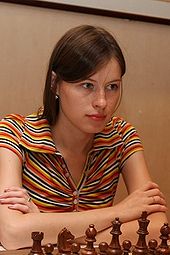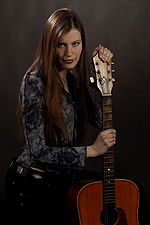
Natalia Pogonina
Encyclopedia
Natalia Andreevna Pogonina (born March 9, 1985 in Vladivostok
, Russian SFSR
) is a Russian chess
Woman Grandmaster and member of the Russian Olympic chess team.
 Pogonina learned to play chess at the age of five, as her grandfather taught her the basics of the game. She has been studying chess since 1993 after winning the school’s checkers tournament.
Pogonina learned to play chess at the age of five, as her grandfather taught her the basics of the game. She has been studying chess since 1993 after winning the school’s checkers tournament.
She achieved notice for the first time in 1998 when she won the Russian Girls under-14 National Championship. Natalia Pogonina has won the European Chess Championships among girls thrice, and has also been awarded a bronze medal at the World Junior Chess Championship. Some of her other victories include winning the Bykova Memorial in 2005, Rudenko Memorial in 2007, bronze medal at North Urals Cup chess super tournament and sharing first place at the World Student Chess Championship in 2008.
Her latest successes have been winning the gold medal in team blitz and bronze medal in team rapid chess at the first World Mind Sport Games in Beijing and scoring 6/7 on Board 5 (Russian team) in the Chess Olympiad
in 2008. She finished first (with 8 points from 9 games) at the prestigious Moscow Open 2009, and won the bronze medal at the European Women Championship 2009 (on tie-breaks). In 2011 Natalia Pogonina won gold medals at both the European Club Cup and the European Team Chess Championship.
In 2004, Natalia Pogonina was awarded the title of Woman Grandmaster. She is fifteenth on the July 2010 FIDE
women Elo rating list with a rating of 2501.
.
 Pogonina is currently studying for an MA
Pogonina is currently studying for an MA
in law at the Saratov
State Academy of Law. Her hobbies include flamenco
, music, photography, travelling, sports, literature and poetry. Her handle on the Internet Chess Club
is "Bagira".
On June 5, 2009, she married IT-specialist and debate expert Peter Zhdanov. They have a son named Nikolai (born November 18, 2009).
over former FIDE Women's World Champion Antoaneta Stefanova
, Natalia Pogonina became co-leader in the North Urals Cup-2007 tournament. (Analysis by T. Grabuzova, ChessPro)
1.e4 e5 2.Nf3 Nc6 3.Bb5 a6 4.Ba4 Nf6 5.0-0 Bc5 6.c3 b5 7.Bc2 d6 8.a4 Bg4 9.h3 Bxf3 10.Qxf3 b4 11.a5 0–0 12.d3 Rb8 13.Nd2 d5 14.exd5 bxc3 15.bxc3 Nd5 (See diagram) 16.d4 More solid is 16. Qe4 with similar ideas, but without sacrificing a pawn. 16...exd4 17.Qd3 g6 17…Nf6 doesn’t work since after 18.Ne4 Nxe4 19.Qxe4 White come up with the decisive fork
. 18.Qc4 18.Qxa6 could be met with 18…Ne5 with the idea to counter 19.Ne4 with a nice move 19…Nxc3! White has to decide whether to force a draw by playing 20.Nxc5 Ra8 21.Qb7 Rb8 or to try to demonstrate the potential of the passed a-pawn, supported by two bishops, after 20.Nxc3 dxc3 which led to a position with mutual chances. 18…Rb5 19.Ne4 Ne5? White’s decisiveness is awarded surprisingly quickly. This mistake seems to be uncharacteristic of Antoaneta Stefanova who is in general in her cup of tea when playing complicated positions with tactical opportunities for both sides. And here comes the blunder! After a reasonable 19…Nc3 White would have been facing certain problems. For instance, 20.Bg5 (White’s queen is badly placed. So, 20.Nxc5? loses immediately to 20…Ne5, while after 20.Nxc3 dxc3 the threats Ne5 and Nxa5 leave white feeling uncomfortable) is answered by 20…Qc8 21.Nc3 (21.Nxc5? Ne5) 21...dxc3 22.Bf6 (22.Qxc3? Bd4 23.Qxc6 Bxa1 and white has no real compensation for the sacrificed material) 22…Qe6 23.Qxc3 Bb4 White can’t develop the initiative: 24.Qf3 Ne5 25.Qf4 Rxa5 26.Rab1 Be7 27.Bxe7 Qxe7 28.Rfe1 f6 leaves black with two “healthy” extra pawns for no real compensation. However, after Black’s mistake the rest is simple: 20.Qxd5 d3 21.Qxd8 Rxd8 22.Ba4 Rxa5 23.Bg5 Rb8 24.Bf6 Bf8 25.Bxe5 25...Rxe5 26.Nf6+ and 27.Nd7 1-0
Vladivostok
The city is located in the southern extremity of Muravyov-Amursky Peninsula, which is about 30 km long and approximately 12 km wide.The highest point is Mount Kholodilnik, the height of which is 257 m...
, Russian SFSR
Russian Soviet Federative Socialist Republic
The Russian Soviet Federative Socialist Republic , commonly referred to as Soviet Russia, Bolshevik Russia, or simply Russia, was the largest, most populous and economically developed republic in the former Soviet Union....
) is a Russian chess
Chess
Chess is a two-player board game played on a chessboard, a square-checkered board with 64 squares arranged in an eight-by-eight grid. It is one of the world's most popular games, played by millions of people worldwide at home, in clubs, online, by correspondence, and in tournaments.Each player...
Woman Grandmaster and member of the Russian Olympic chess team.
Chess career

She achieved notice for the first time in 1998 when she won the Russian Girls under-14 National Championship. Natalia Pogonina has won the European Chess Championships among girls thrice, and has also been awarded a bronze medal at the World Junior Chess Championship. Some of her other victories include winning the Bykova Memorial in 2005, Rudenko Memorial in 2007, bronze medal at North Urals Cup chess super tournament and sharing first place at the World Student Chess Championship in 2008.
Her latest successes have been winning the gold medal in team blitz and bronze medal in team rapid chess at the first World Mind Sport Games in Beijing and scoring 6/7 on Board 5 (Russian team) in the Chess Olympiad
Chess Olympiad
The Chess Olympiad is a biennial chess tournament in which teams from all over the world compete against each other. The event is organised by FIDE, which selects the host nation.-Birth of the Olympiad:The first Olympiad was unofficial...
in 2008. She finished first (with 8 points from 9 games) at the prestigious Moscow Open 2009, and won the bronze medal at the European Women Championship 2009 (on tie-breaks). In 2011 Natalia Pogonina won gold medals at both the European Club Cup and the European Team Chess Championship.
In 2004, Natalia Pogonina was awarded the title of Woman Grandmaster. She is fifteenth on the July 2010 FIDE
Fédération Internationale des Échecs
The Fédération Internationale des Échecs or World Chess Federation is an international organization that connects the various national chess federations around the world and acts as the governing body of international chess competition. It is usually referred to as FIDE , its French acronym.FIDE...
women Elo rating list with a rating of 2501.
Pogonina vs the World
Natalia Pogonina defeated the World with White in a vote chess game that took part at Chess.com from December 23, 2009 to March 28, 2010. A few thousand players from over 100 countries participated. A re-match game against the World has been played at ChessGames.com and ended in a drawDraw (chess)
In chess, a draw is when a game ends in a tie. It is one of the possible outcomes of a game, along with a win for White and a win for Black . Usually, in tournaments a draw is worth a half point to each player, while a win is worth one point to the victor and none to the loser.For the most part,...
.
Personal life

Master of Arts (postgraduate)
A Master of Arts from the Latin Magister Artium, is a type of Master's degree awarded by universities in many countries. The M.A. is usually contrasted with the M.S. or M.Sc. degrees...
in law at the Saratov
Saratov
-Modern Saratov:The Saratov region is highly industrialized, due in part to the rich in natural and industrial resources of the area. The region is also one of the more important and largest cultural and scientific centres in Russia...
State Academy of Law. Her hobbies include flamenco
Flamenco
Flamenco is a genre of music and dance which has its foundation in Andalusian music and dance and in whose evolution Andalusian Gypsies played an important part....
, music, photography, travelling, sports, literature and poetry. Her handle on the Internet Chess Club
Internet Chess Club
The Internet Chess Club is a commercial Internet chess server devoted to the play and discussion of chess and chess variants. ICC currently has over 30,000 subscribing members...
is "Bagira".
On June 5, 2009, she married IT-specialist and debate expert Peter Zhdanov. They have a son named Nikolai (born November 18, 2009).
Sample game
After this 25-move victory with the Neo-Archangelsk variation of Ruy LopezRuy Lopez
The Ruy Lopez, also called the Spanish Opening or Spanish Game, is a chess opening characterised by the moves:-History:The opening is named after the 16th century Spanish priest Ruy López de Segura, who made a systematic study of this and other openings in the 150-page book on chess Libro del...
over former FIDE Women's World Champion Antoaneta Stefanova
Antoaneta Stefanova
Antoaneta Stefanova is a Bulgarian chess grandmaster, and a former Women's World Chess Champion. She became the twelfth holder of that title in 2004 in a 64-player knockout tournament held in Elista, Kalmykia under the auspices of FIDE....
, Natalia Pogonina became co-leader in the North Urals Cup-2007 tournament. (Analysis by T. Grabuzova, ChessPro)
1.e4 e5 2.Nf3 Nc6 3.Bb5 a6 4.Ba4 Nf6 5.0-0 Bc5 6.c3 b5 7.Bc2 d6 8.a4 Bg4 9.h3 Bxf3 10.Qxf3 b4 11.a5 0–0 12.d3 Rb8 13.Nd2 d5 14.exd5 bxc3 15.bxc3 Nd5 (See diagram) 16.d4 More solid is 16. Qe4 with similar ideas, but without sacrificing a pawn. 16...exd4 17.Qd3 g6 17…Nf6 doesn’t work since after 18.Ne4 Nxe4 19.Qxe4 White come up with the decisive fork
Fork
As a piece of cutlery or kitchenware, a fork is a tool consisting of a handle with several narrow tines on one end. The fork, as an eating utensil, has been a feature primarily of the West, whereas in East Asia chopsticks have been more prevalent...
. 18.Qc4 18.Qxa6 could be met with 18…Ne5 with the idea to counter 19.Ne4 with a nice move 19…Nxc3! White has to decide whether to force a draw by playing 20.Nxc5 Ra8 21.Qb7 Rb8 or to try to demonstrate the potential of the passed a-pawn, supported by two bishops, after 20.Nxc3 dxc3 which led to a position with mutual chances. 18…Rb5 19.Ne4 Ne5? White’s decisiveness is awarded surprisingly quickly. This mistake seems to be uncharacteristic of Antoaneta Stefanova who is in general in her cup of tea when playing complicated positions with tactical opportunities for both sides. And here comes the blunder! After a reasonable 19…Nc3 White would have been facing certain problems. For instance, 20.Bg5 (White’s queen is badly placed. So, 20.Nxc5? loses immediately to 20…Ne5, while after 20.Nxc3 dxc3 the threats Ne5 and Nxa5 leave white feeling uncomfortable) is answered by 20…Qc8 21.Nc3 (21.Nxc5? Ne5) 21...dxc3 22.Bf6 (22.Qxc3? Bd4 23.Qxc6 Bxa1 and white has no real compensation for the sacrificed material) 22…Qe6 23.Qxc3 Bb4 White can’t develop the initiative: 24.Qf3 Ne5 25.Qf4 Rxa5 26.Rab1 Be7 27.Bxe7 Qxe7 28.Rfe1 f6 leaves black with two “healthy” extra pawns for no real compensation. However, after Black’s mistake the rest is simple: 20.Qxd5 d3 21.Qxd8 Rxd8 22.Ba4 Rxa5 23.Bg5 Rb8 24.Bf6 Bf8 25.Bxe5 25...Rxe5 26.Nf6+ and 27.Nd7 1-0
Further reading
- Natalia Pogonina's official website
- Pogonina's old website
- Interview with Woman Grandmaster Natalia Pogonina at Chessdom site, 2008
- Interview with Natalia Pogonina at Befree site (Befree’s Choice Award), 2008
- Photo collection of Natalia Pogonina and other members of the Russian Chess Team
- Chessportal.ru: Interview with Natalia Pogonina, 2003
- Natalia Pogonina’s interview, 2003
- Video report – Russian Chess Team at the 1st Mind Sport Games
- LatestChess – Interview with WGM Natalia Pogonina, 2009

